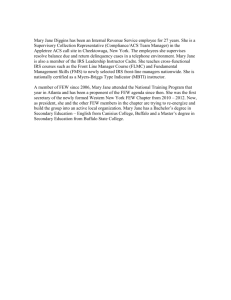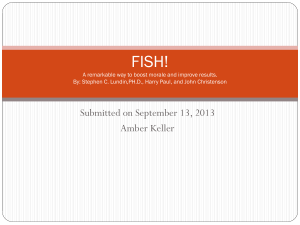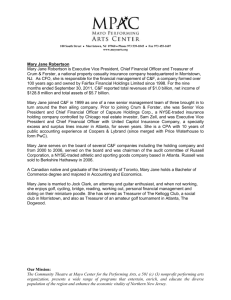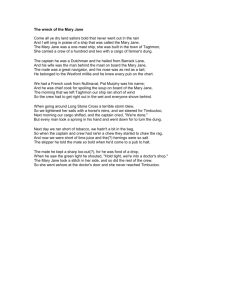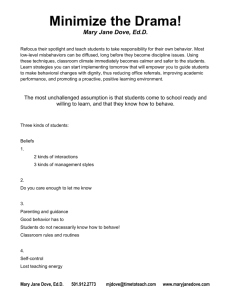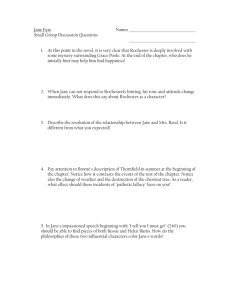AMA Style Fish! Report
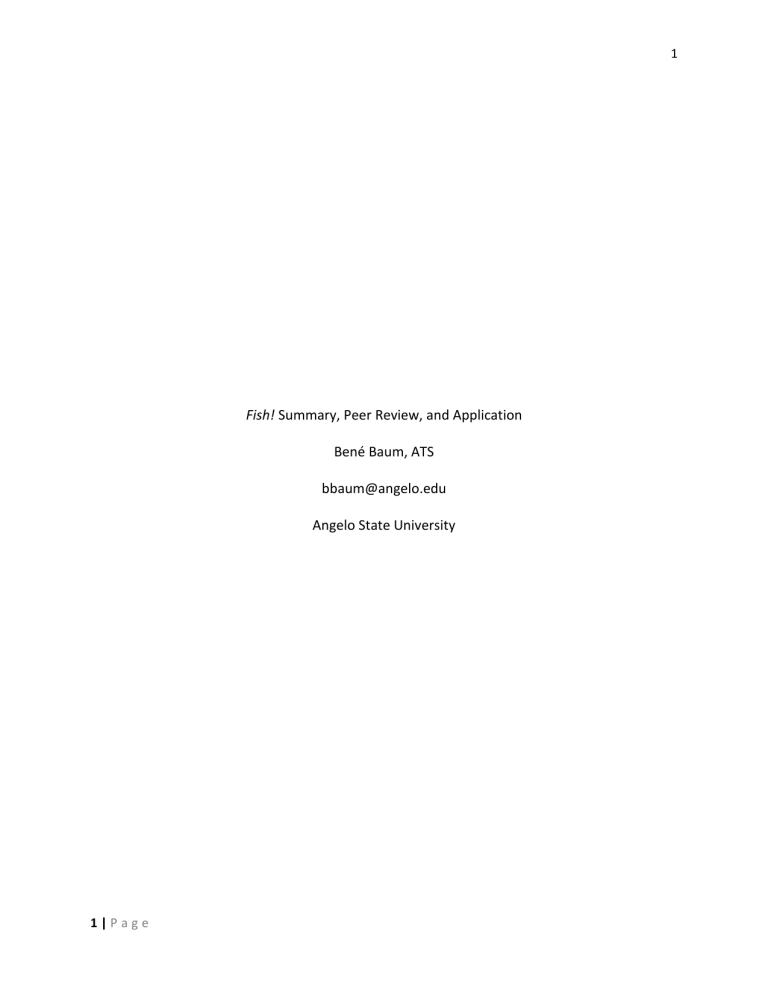
Fish! Summary, Peer Review, and Application
Bené Baum, ATS bbaum@angelo.edu
Angelo State University
1
1 | P a g e
1 Lundin, Paul, and Christensen, the authors of Fish! portray a story of a woman, Mary
2 Jane, who leads quite the ideal life including an easily enjoyable job, two kids, and a working
3 husband who have recently moved and started a new life. This life is short-lived once her
4 husband gets sick and passes. Following such an event, Mary Jane is then reassigned to be
5 manager over the reputable third floor of her company. This third floor is known for sour
6 attitudes, unkindly customer care, and untimely functioning. The third floor is a dreaded
2
7 reassignment for Mary Jane. It is now her job to redirect this group of employees of who have
8 tenure and stubborn habits.
9 After being reassigned as the third floor department manager, Mary Jane hardly
10 attempts to lead by example. Getting accustomed to her husband’s absence with two children
11 to raise, a job offering more money at the price of being emotionally drained by a demanding
12 yet less than enthusiastic department of employees, Mary Jane soon discovers a remedy at an
13 uncommonly place known as Pike’s Fish Market. After being amazed over thrown fish and the
14 welcoming, fun, yet focused demeanor of the employees of such a tedious, disgusting however,
15 enjoyable job Mary Jane is introduced to a new kind of working environment when meeting
16 one of the fish market men, Lonnie.
17 After witnessing such a sight, Mary Jane then thought of what the third floor just might
18 have potential to become. She then embarked on a mission to learn from Lonnie just how a job
19 such as working at a fish market could be known for its fun, enjoyable, and enthusiastic
20 reputation. Through discussions and meetings with Lonnie, Mary Jane commits to leading the
21 third floor as manager to change the reputation of the dull department and to instill motivation
22 and drive within her employees. Fish! Tells of the means by which the third floor manager picks
2 | P a g e
23 up her department employees, dusts them off, and gets their gears running again. By instilling
3
24 knowledge that the workplace is more than just a place to perform tedious work, Fish! Spells
25 out that in a work environment improvement, commitment, and enjoyable personalities can
26 only be met if 4 criteria are met within the workplace. Mary Jane learns to implement these
27 criteria within her department.
28 First, each employee must choose their attitude every day. By choosing to be effective,
29 leave home at home and being helpful and pleasant each employee will contribute to their own
30 day and to others’ as well. Second, the workplace must devote efforts in a state of play. Lonnie
31 worked at a fish market that was known for entertainment of flying fish, jokes, and great
32 quality sea food. They had fun putting on shows yet making sales at the same time to avoid
33 monotonous, boring work. Third, make the customers’ day. Happy customers reflect happy and
34 helpful employees. Happy customers return and advocate. By including the person receiving
35 service this establishes a quality relationship and great report. Lastly, be present. Be attentive
36 to the customer’s needs. Be focused on tasks and work efficiently at the task at hand. This also
37 means to be present with co-workers and colleagues. Be helpful and aid in instruction if aid is
38 required or a task is being executed incorrectly. All 4 of these criteria are essential in making a
39 positive influence when leading in a working environment.
40 Within Fish! Mary Jane is a person placed in a leadership position. Being a manager, she
41 is the third floor’s department head. When feedback is brought to the company in regards of
42 the third floor it is reported to her. Leadership positions are difficult to fill. This can partly be
43 attributed to a statement made: “‘an important component of leadership is achieving expertise
44 in a given are, thus inspiring others to follow and learn.’” 1 Mary Jane did her research; she
3 | P a g e
45 applied her realizations to her own life followed by demonstrating the 4 criteria every day at
4
46 work. Once she was working on her own attitude and leadership skills she then involved her
47 colleagues and employees. She became an expert and carried over that inspiration to perform
48 better to those she worked with and led. Like the authors wrote about, it has been observed
49 that “more than half of the respondents to a recent employee survey insist that they feel
50 ‘stagnant’ in their jobs…” 1 This feeling is real in the workplaces of today. People look for a new,
51 exciting job or career in which they will be challenged, meet new goals and welcome new and
52 insightful experiences all while learning yet having a great time. However, all too often people
53 work and get caught in tedious jobs that no longer offer those sought-after opportunities.
54 When this situation arises, a “stagnant” state is no surprise, although it is not ideal. This state is
55 characterized by an employee becoming monotonous, possibly less efficient, and feeling
56 depreciated. Harward’s idea to correct this flaw within the workplace is to “… give these
57 employees the challenges they’re seeking and trust them more. Let them know how their
58 activities contribute to a broader agenda.” 1 In the book, Mary Jane split her department into
59 two groups and met with them regularly in order to discuss improvements, concerns, and their
60 purpose for the company. Despite boring paperwork and tedious tasks, Mary Jane placed new
61 challenges of group betterment activities, tasks, and individual improvement methods in front
62 of her colleagues.
63 The same issues and concerns can and are going to occur with athletic training students
64 such as ourselves. A general statement that many would most likely agree with is that people
65 choose the field of athletic training for excitement and a fulfilling duty. Being around the
66 hospitals, clinics, high schools, and university athletics; one would expect high paced and
4 | P a g e
67 electrifying experiences. However, all too many occurrences lead to athletic training students
5
68 becoming bored or restless or overwhelmed. This could be to lack of current events, tedious
69 drawn out work that comes with the territory or overloaded clinical hour overload. With
70 generally tough school loads and hours of clinical work students find themselves fed-up, worn
71 down, or un-intrigued. Eventually, this can lead to feeling unappreciated as well. Athletic
72 training students, LATs, ATCs like employees “want to contribute by doing work that matters
73 and feel valued while doing so.” 1 However, how do we go about correcting the situation in
74 order for them to fully contribute again and feel valued? Refer back to Fish!: Choose your
75 attitude, play, make their day, and be present.
2
76 As an athletic training student it is crucial to change the nature of our work.
1 Not only
77 do athletic training students need to be concerned about their own work and school related
78 issues but, just as Mary Jane learned to leave home at home we have to leave everything else
79 behind before entering a class or the athletic training room. Once in class, profession and
80 learning are what we must be present for. And while in the athletic training room or out on the
81 site, our focus must be on our “customers”- the athletes we are caring for.
2
82 Just as we are taught throughout our classes our attitudes will ultimately affect our
83 “customers,” the athletes when they come to see us. Therefore, we must choose our attitude
84 and make their day. As for our co-workers – the other athletic training students, observing
85 freshman, Gas, or ATs- in order to improve the workplace, we must be willing to assist, learn,
86 listen, be present, play yet be focused, and make their day as well.
87 In conclusion the 4 criteria mentioned must be broken down into their 2 driving forces:
88 a.) work motivation- described as intrinsic as well as extrinsic forces from within a person’s
5 | P a g e
6
89 being “to initiate work-related behavior and to determine its form, direction, intensity, and
90 duration”; and b.) commitment- described as a force that binds an individual to a means of
91 achieving a goal or reaching a target.
3 By these 2 forces employees as well as leaders can strive
92 and accomplish the 4 criteria needed to improve their work environment. As students let us “do
93 more teaching and less telling” when it comes to our athletes and co-workers to ensure we are
94 all being provided with the best of ourselves and each other in the educational and work
95 environments.
1
References
1. Harris P. LEADERSHIP Role Models Earn TRUST AND PROFITS. T+D[serial online]. March 2010;
64(3):46-50. Available from: Academic Search Complete, Ipswich, MA. Accessed September 26,
2011.
2. Lundin S, Paul H, Christensen J. Fish! [Print]. Hyperion, New York: Hyperion Books; 2000: 78
3. Meyer J, Becker T, Vandenberghe C. Employee Commitment and Motivation: A Conceptual
Analysis and Integral Model. Journal of Applied Psychology. 2004; 89(6):991-1007. Available from: Academic Search Complete, Ipswich, MA. Accessed September 26, 2011.
6 | P a g e
